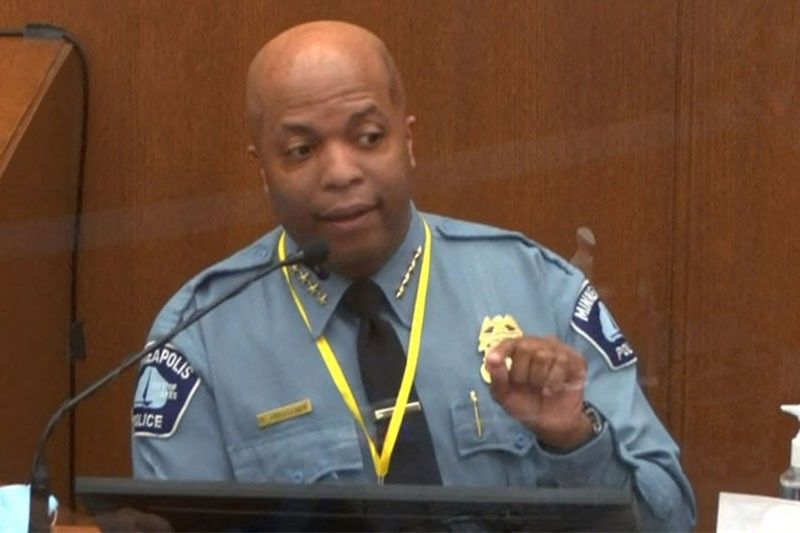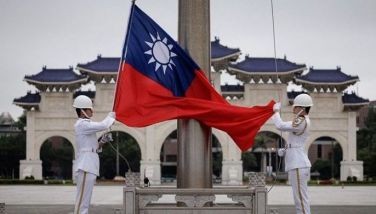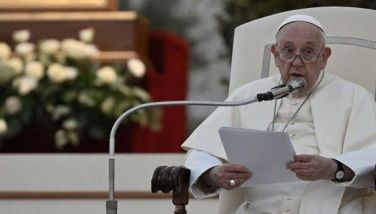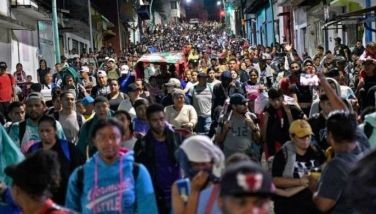Kneeling on Floyd's neck violated policy, 'values': police chief

MINNEAPOLIS, United States — Minneapolis police chief Medaria Arradondo testified on Monday that officer Derek Chauvin violated the department's training policies and its "values" by kneeling on George Floyd's neck after he had stopped resisting.
Arradondo, called as a prosecution witness at Chauvin's murder trial, said the use of force against Floyd was reasonable during the "first few seconds" of his May 25, 2020 arrest but it should have ended quickly.
"It is contrary to our training to indefinitely place your knee on a prone, handcuffed individual for an indefinite length of time," the police chief of the Minnesota city said.
"That in no way, shape or form is anything that is by policy," he said. "It is not part of our training and it is certainly not part of our ethics or our values.
"Once Mr. Floyd had stopped resisting, and certainly once he was in distress and trying to verbalize that, that should have stopped," Arradondo said.
The 45-year-old Chauvin, who is white, was seen in a video taken by a bystander kneeling on the neck of a handcuffed Floyd for more than nine minutes as the 46-year-old African-American man complained repeatedly that he "can't breathe."
Arradondo, 54, Minneapolis's first Black police chief, fired Chauvin and the three other officers involved in the arrest that led to Floyd's death the day after the incident.
The harrowing video of Floyd's arrest touched off protests against racial injustice and police brutality in the United States and around the world.
Chauvin has pleaded not guilty to charges of murder and manslaughter.
Another senior Minneapolis police officer, Inspector Katie Blackwell, testified on Monday about the training in the use of force that Chauvin and other officers received.
Blackwell, who headed the police training unit, was shown a picture of Chauvin kneeling on Floyd's neck and asked if that was an approved neck restraint.
"I don't know that kind of improvised position that is," she said. "It's not what we train."
'Hypoxia'
Eric Nelson, Chauvin's attorney, introduced video at one point that he said showed Chauvin's knee on Floyd's shoulder blade and not on his neck.
Prosecutors countered that the video depicted the moment when paramedics arrived and Chauvin had removed his knee from Floyd's neck to get up.
Also testifying on Monday was the doctor who treated Floyd when he was brought to the emergency room at the Hennepin County Medical Center.
Bradford Wankhede Langenfeld said Floyd was in cardiac arrest when he arrived and 30 minutes of efforts to revive him were unsuccessful.
He said a lack of oxygen was the most likely reason Floyd's heart had stopped beating.
"I felt that hypoxia was one of the more likely possibilities," Langenfeld said.
Prosecutors are seeking to prove that Floyd's death was due to asphyxiation while Chauvin's defense attorney claims it was due to illegal drugs in his system.
Langenfeld said the two paramedics who brought Floyd to the hospital did not mention any drug use or the possibility that he had overdosed.
Arradondo and Blackwell were the latest police officers to be called by the prosecution to testify against Chauvin.
Lieutenant Richard Zimmerman, the longest-serving officer in the Minneapolis Police Department, testified last week that Chauvin's use of force against Floyd was "totally unnecessary."
Zimmerman said he had reviewed bystander and police bodycam video of Floyd's arrest and Chauvin had violated department policies on the use of force.
"Pulling him down to the ground facedown and putting your knee on a neck for that amount of time, it's just uncalled for," Zimmerman said.
The first five days of the trial also featured emotional testimony from bystanders who witnessed the arrest and urged Chauvin to remove his knee from Floyd's neck.
The nine-woman, five-man jury hearing the case in a heavily guarded Minneapolis courtroom has also been repeatedly shown the graphic video of Floyd's arrest.
Chauvin faces up to 40 years in prison if convicted of the most serious charge — second-degree murder.
The other three former police officers involved in the arrest — Tou Thao, Thomas Lane, and J. Alexander Kueng — are to be tried separately later this year.
Los Angeles, Philadelphia and Atlanta were among several US cities to announce curfews Saturday in a bid to stem violent anti-police protests breaking out across America.
A nighttime curfew was also implemented in Louisville, Kentucky as the United States continues to be rocked by demonstrators angry at the death of a black man during an arrest in Minneapolis on Monday.
George Floyd was handcuffed and died after a police officer knelt on his neck for nearly nine minutes, sparking the widespread protests against police brutality. — AFP
Photo: Demonstrators confront secret service police officers outside of the White House on May 30, 2020 in Washington DC, during a protest over the death of George Floyd, an unarmed black man, who died after a Minneapolis police officer kneeled on his neck for several minutes. Demonstrations are being held across the US after George Floyd died in police custody on May 25. Jose Luis Magana / AFP
Derek Chauvin, the former Minneapolis police officer convicted of the murder of George Floyd, was sentenced to more than 20 years in prison on Thursday on federal charges.
Chauvin, who is white, pleaded guilty in December 2021 to violating the civil rights of Floyd, a 46-year-old Black man, during his May 2020 arrest for allegedly using a counterfeit $20 bill to buy a pack of cigarettes.
Chauvin is already serving a 22-and-a-half-year sentence after being convicted of state murder charges for Floyd's death, which sparked protests against racial injustice and police brutality across the United States. — AFP
Several hundred protesters marched Sunday in Akron, Ohio after the release of body camera footage that showed police fatally shooting a Black man with several dozen rounds of bullets.
As anger rose over the latest police killing of a Black man in the United States, and authorities appealed for calm, a crowd marched to City Hall carrying banners with slogans such as "Justice for Jayland."
The slogan refers to Jayland Walker, 25, who was killed Monday after officers tried to stop his car over a traffic violation, police said.
Sunday marked the fourth straight day of protests. Demonstrations were peaceful but for a tense moment in which some protesters got close to a line of police and shouted at them.
After the first rally, a crowd of people remained in the street protesting.
Fearing potential unrest, authorities in the city of 190,000 people moved snowplows and other heavy equipment near the police department to serve as a barrier.
After initially providing few details of the shooting, Akron authorities released two videos Sunday: one that was a compilation of body-camera footage, body-cam still frames and voiceover, and another of the complete body-cam footage of the entire chase and shooting.
The voiceover explained that Walker did not stop and drove off. Police engaged in a car chase and said a shot had been fired from Walker's vehicle.
After being chased for several minutes, Walker got out of his car while it was still moving and fled on foot. Officers tried to subdue him with their tasers, but he kept running.
Several officers finally chased Walker to a parking lot. The body-cam footage is too blurry to see clearly what happens, but an initial police statement released after the shooting says he behaved in a way that caused officers to believe he posed a "deadly threat."
All of the officers at the scene opened fire on Walker, shooting multiple times in rapid succession.
He was pronounced dead at the scene. — AFP
A Minnesota jury begins deliberating the fate of three former police officers charged with violating the civil rights of George Floyd, the African American man whose murder sparked nationwide protests.
Tou Thao, 36, J. Alexander Kueng, 28, and Thomas Lane, 38, are on trial in federal court in Saint Paul for their roles in Floyd's May 2020 death in the sister city of Minneapolis.
"It's your duty to find the facts," Judge Paul Magnuson tells the jury of eight women and four men, "and then apply the law."
"Don't allow sympathy or prejudice to influence you," the judge says before sending the jurors off to begin their deliberations. — AFP
Sculptures of George Floyd and Breonna Taylor, two Black Americans whose deaths at the hands of police in 2020 rocked the United States, are to be auctioned for charity after being exhibited in New York, Sotheby's said Thursday.
The pieces will be on sale online until December 17 and the profits will go to associations founded by the families of the two victims, "We are Floyd" and "The Breonna Taylor Foundation," Sotheby's said.
The two statues are the work of artist Chris Carnabuci, while the statue of Taylor has been decorated by Brooklyn-based Nigerian artist Laolu Senbanjo, also known as Laolu NYC, who has worked with Beyonce in the past.
The golden statue of George Floyd, who was killed last May at age 46 when a white Minneapolis police officer knelt on his neck for some nine minutes, had been vandalized with spray paint while on display in Union Square in Manhattan.
It has since been cleaned up, and the 1.8 meter (six foot) sculpture is expected go for between $100,000 and $150,000. — AFP
A US court has handed down a four-year sentence to a former police officer charged with illegally beating a Black undercover colleague posing as a protester at a 2017 demonstration.
A federal judge on Tuesday sentenced Randy Hays, 34, to more than four years in jail after the former cop pleaded guilty in 2019 to using excessive and unreasonable force, according to court documents.
Hays, along with former officers Dustin Boone and Christopher Myers were accused of knocking to the ground an undercover officer who was monitoring protesters, and then kicking and striking the officer with a police baton.
On Thursday, another former officer, Bailey Colletta, was given a three-year suspended sentence for lying to a federal grand jury during its investigation of the incident.
Boone was found guilty by a jury in June and is due to be sentenced on September 15, exactly four years after the incident. — AFP
- Latest
- Trending


































